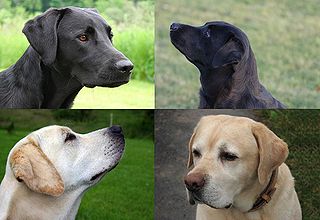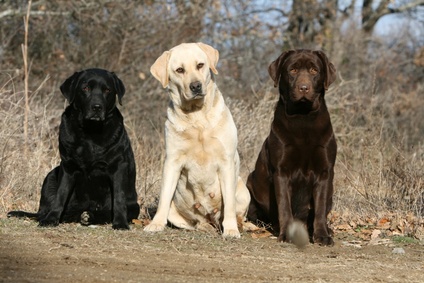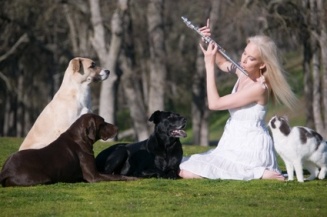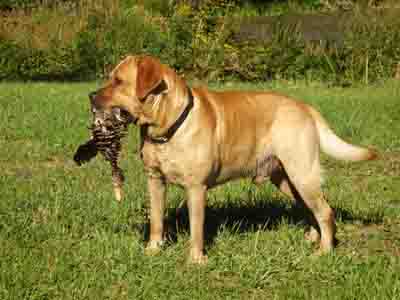Must Learn About English Labrador Coat Colours
Genes control English Labrador coat colours and play the decisive role in deciding whether a Lab puppy will have a coat coloured either yellow, black or chocolate.

American Labradors (left) and English Labs (right)
Coat colours are very important to breeders and owners alike and of course knowing which genes are present in the parents gives a very good guide to what coat colour the newborn puppies will have.
Despite the large number of ‘shades’ in English Labrador coat colours such as red and silver the English and American kennel clubs only recognise three colours and they are black, yellow and chocolate (brown).
This article by expert vets illustrate how the parent’s genes influence English Labrador coat colours and the chances of different types of parents producing similar coloured puppies.

Two Genes Control Coat Color in Labrador Retrievers
The coat color of Labrador Retrievers (Black, brown (chocolate), or yellow) is controlled by two different genes. The first gene controls the color of the coat, and is either B=Black or b=brown.
Each parent provides the offspring with either a "B" gene or a "b" gene. Black is dominant over brown. This means if either gene from the parent is "B," the offspring's genetic code for coat color will be Black. The genetic combinations include:
- BB = both parents provide a Black gene
- Bb = mother supplies Black, father supplies brown; or mother supplies brown, father supplies Black
- bb = both parents provide a brown gene
An offspring with one or two "B's" will have a Black nose; one with two "b's" would have a brown nose.
The second gene regulates whether the color pigment will actually be deposited in the hair, and is either "E" = permits pigment deposition, or "e" = prevents pigment deposition.
As above, each parent provides the offspring with either an "E" gene or an "e" gene. The "E," which permits pigment, is dominant over "e," which does not permit pigment.
Thus, if either gene from the parent is "E," the offspring's genetic code for coat color pigment (Black or brown) will be deposited. The possible combinations include:
- EE = both parents provide the gene permitting pigment deposition
- Ee = mother supplies the gene permitting deposition, father supplies the gene preventing deposition; or eE = mother supplies the gene preventing deposition, father supplies the gene permitting deposition
- ee = both parents provide the gene preventing deposition

As a result, any Lab that has at least one "B" and one "E" (BBEE, BBEe, BbEE, or (BbEe) will be Black.
A Lab that has two "b's" and at least one "E" (bbEE or bbEe) will be brown.
A Lab that has two "e's," regardless of whether it has "B's" or "b's" (BBee, Bbee, or bbee) will be yellow.
You may wonder why some yellow Labs have Black noses and lips.
It turns out that the "e" gene does not prevent deposition of color in the nose or lips as it does in the coat.
Therefore, "BBee" and "Bbee" yellow Labs have Black noses and lips, while "bbee" yellow Labs have brown noses and lips. Note, though, some Labs lose their nose color as they age, so nose color may not be a good indication of the actual genotype of a Lab.
The possible gene types for Labrador Retrievers are shown below.
| Gene Types | Coat Color | Nose Color | Hidden Color | EEBB | Black | Black | – | EeBB | Black | Black | yellow | EEBb | Black | Black | brown (chocolate) | EeBb | Black | Black | yellow and brown (chocolate) | eeBB | yellow | Black | Black | eeBb | yellow | Black | Black and brown (chocolate) | eebb | yellow | brown | brown (chocolate) | EEbb | brown (chocolate) | brown | – | Eebb | brown (chocolate) | brown | yellow |
|---|
| Genes from true Black parent BE |
|
|---|---|
| Genes from true yellow parent be |
BbEe (Black carrying a gene for brown and a gene for yellow) |
| Genes from Parent 2 | Genes from Parent 1 | |||
|---|---|---|---|---|
| BE | Be | bE | be | |
| BE | BBEE (pure for Black | BBEe (Black carrying yellow) | BbEE (Black carrying brown) | BbEe (Black carrying brown and yellow) |
| Be | BBEe (Black carrying yellow) | BBee (pure for yellow; Black nose) | BbEe (Black carrying brown and yellow) | Bbee (yellow carrying brown; Black nose) |
| bE | BbEE (Black carrying brown) | BbEe (Black carrying brown and yellow) | bbEE (pure for brown) | bbEe (brown carrying yellow) |
| be | BbEe (Black carrying brown and yellow) | Bbee (yellow carrying brown; Black nose) | bbEe (brown carrying yellow) | bbee (yellow; brown nose) |
- BBEE - True Black (occurs once out of 16 times)
- BBEe - Black, carrying a gene for yellow (occurs 2 times out of 16)
- BbEE - Black, carrying a gene for brown (occurs 2 times out of 16)
- BbEe - Black, carrying a gene for brown and a gene for yellow (occurs 4 times out of 16)
- bbEE - Brown (occurs once out of 16 times)
- bbEe - Brown, carrying a gene for yellow (occurs 2 times out of 16)
- BBee - Yellow, carrying a gene for Black (occurs once out of 16 times)
- Bbee - Yellow, carrying a gene for Black and a gene for brown (occurs 2 times out of 16) In this mating between two Black dogs, both carrying brown and yellow, there is a 9/16 probability that a particular puppy will be Black, a 3/16 probability that the puppy will be brown, and a 4/16 probability that the puppy will be yellow. Now you can see why, in many cases, the colors of the offspring in a litter can be varied, and different than the parents. © 2008 Drs. Foster and Smith, Inc. Reprinted as a courtesy and with permission from PetEducation.com

Picture of Fox Red English Labrador
Source: Askolnick